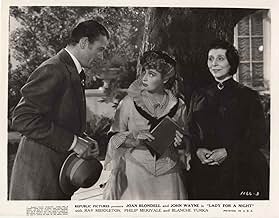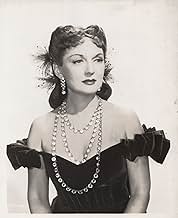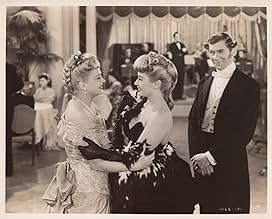Ajouter une intrigue dans votre langueGambling boat operator Jenny Blake throws over her gambler beau Jack Morgan in order to marry into high society.Gambling boat operator Jenny Blake throws over her gambler beau Jack Morgan in order to marry into high society.Gambling boat operator Jenny Blake throws over her gambler beau Jack Morgan in order to marry into high society.
Hall Johnson Choir
- Singers
- (as The Hall Johnson Choir)
Fred Aldrich
- Member of Quartet
- (uncredited)
Histoire
Le saviez-vous
- AnecdotesThis film inspired the name of one of the most famous World War 2 bombers, the B-17 "Memphis Belle", one of the first to complete a full combat tour of 25 missions against targets in Nazi Germany in May 1943. The aircraft was the namesake of pilot Captain Robert K. Morgan's sweetheart, Margaret Polk, a resident of Memphis, Tennessee. Morgan originally intended to call the B-17, Little One, after his pet name for her, but after Morgan and his co-pilot, Jim Verinis, saw this movie in which the leading character owns a riverboat named the Memphis Belle, he proposed that name to his crew. After their combat service, the Belle and her crew were sent home on highly successful war bond tour. They were also featured in an award-winning 1944 documentary by William Wyler.
- Générique farfeluUnderneath the credits, there is some footage of extras dancing in front of the Alderson family's house.
- Bandes originalesUp in a Balloon
(uncredited)
Written by Henry B. Farnie (1868)
Special Lyrics by Sol Meyer
Sung by Joan Blondell, a quartet and chorus on the Memphis Belle
Whistled by John Wayne
Played as backgroung music often
Commentaire en vedette
This movie was made in 1942. It is one of several movies that Joan Blondell, a very popular actress of the time, made in that year.
I think when you look at a movie of this type, which was an average, run-of-the-mill movie of the time, what you get out of it is a snapshot of what viewers of the day expected to see in a movie. While this movie is a period piece (looks like it takes place in 1875-1885) it says much about 1942-- what people then would view as acceptable viewpoints for the script to put forth.
I think there are two major themes in this movie that can give today's viewers an historical insight as they are entertained --the attitudes that were allowed to be expressed in that day and time about black Americans, and the Lost Cause mythology. While one character expresses the thought "Abraham Lincoln done emancipated and proclamated me", you can't tell it from this show. A black female leading character (a character actress with a lot of talent) is consistently spoken to with utter disregard for her feelings or human rights. She is threatened with banishment to Africa, is required to be seated in a segregated balcony with other black Americans, and is condescendingly referred to as "Auntie" by a white policeman, a sobriquet to which she responds in a small, frightened voice. An elderly black actor, portraying a coachman and major domo combination, epitomizes the myth of the faithful black retainer, happy to be subservient and defined by white social mores, long after Emancipation. Black residents of the Alderson Plantation are portrayed as lazy do-nothings. This group of people, in the party scene, are forced to enact the sham of being happy, joyful folk singing spirituals and swilling corn liquor on the porches of their shacks. The black actors in this movie mug, roll their eyes, and in general follow the degrading norms set for blacks in the entertainment world of 1942, which was dictated by black-face comedy-- an odious farcial comedy common in the south, which was acted out by white men.
An arresting black character in this movie is Joe, the Conjure man. Joe is an emaciated elderly black soothsayer, who seems frail, yet filled with a power not of his own making, who colors each scene, in which he sings his discordant rhymes, with foreboding. The belief in conjuration, which might be simply defined as the practice of gaining ascendancy over one's adversaries or those one wishes to sway through tricks or spells placed upon them, was brought to American shores from Afica. American authors James Chestnutt and Zora Neale Hurston deal with conjure themes in some of their stories.
The Lost Cause myth forms the framework upon which this story is arranged. The movie Gone with the Wind was released 6 years prior to Lady for a Night. The plantation in ruins, with a formerly noble family now fallen on hard times, eking out lives of genteel poverty due to their Confederate sympathies within its crumbling walls, is a scene familiar to anyone who has viewed Gone With the Wind. The Shadows, the name of the Alderson's ancestral home, is about to fall under the auctioneer's hammer for back taxes, another steal from GWTW. That the South's defeat was the nobler cause was a theme that entered American thought and literature in the early 20th century, as Civil War veterans began to pass away in large numbers, and as their deeds became the stuff of legend. It is interesting to note that this movie was for general release to American audiences, so even the descendants of the soldiers of the Grand Army of the Republic were acquiescent to this view of the South.
I always enjoy scenes reminiscent of vaudeville in movies of the 1930's and 1940's. The scenes set in Jenny Blake's gambling barge (these probably did exist, I haven't researched it) would be familiar to those who had attended vaudeville shows-- joke telling, elaborate musical numbers, dancing girls, and barbershop style male singing.
The costumes in this movie are absolutely first rate, and as a seamstress, I enjoy them each time I watch this movie. Dresses of the late 19th century (as indeed, those of the 1930's) frequently had color combinations, styles, and trimmings that today would seem very garish. Even though the movie is in black and white, the costumes give off an aura as though in color. Whoever designed the costumes, particularly those of Jenny Blake, had an eye for period detail, and access to superb seamstresses. The small bustles are correctly made, the elegant trains drape and move perfectly, and the fit is sublime. All the costumes have been exquisitely fitted to enhance the character-- Aunt Julia, the sinister character of the story, has a perfectly devilish black costume. Jenny Blake's costumes had to hold up to a great deal of active movement and yet they always appear graceful and feminine.
I find it interesting that John Wayne's character-- a behind the scenes political wheeler/dealer, manipulated the affairs of his little empire from his position as the owner of a gambling house. In "The Glass Key", a short story by Dashiell Hammet written in the 1920's, the political power behind the throne wheeler/dealer wields his influence from his gambling house/speakeasy. This must be historical.
Well, this has gotten long. I wanted to let other people know why I like this movie. We can get glimpses of what the people of yesterday were like-- what they approved of, how they related to other people, what made them laugh at the theater, through watching old movies.
I think when you look at a movie of this type, which was an average, run-of-the-mill movie of the time, what you get out of it is a snapshot of what viewers of the day expected to see in a movie. While this movie is a period piece (looks like it takes place in 1875-1885) it says much about 1942-- what people then would view as acceptable viewpoints for the script to put forth.
I think there are two major themes in this movie that can give today's viewers an historical insight as they are entertained --the attitudes that were allowed to be expressed in that day and time about black Americans, and the Lost Cause mythology. While one character expresses the thought "Abraham Lincoln done emancipated and proclamated me", you can't tell it from this show. A black female leading character (a character actress with a lot of talent) is consistently spoken to with utter disregard for her feelings or human rights. She is threatened with banishment to Africa, is required to be seated in a segregated balcony with other black Americans, and is condescendingly referred to as "Auntie" by a white policeman, a sobriquet to which she responds in a small, frightened voice. An elderly black actor, portraying a coachman and major domo combination, epitomizes the myth of the faithful black retainer, happy to be subservient and defined by white social mores, long after Emancipation. Black residents of the Alderson Plantation are portrayed as lazy do-nothings. This group of people, in the party scene, are forced to enact the sham of being happy, joyful folk singing spirituals and swilling corn liquor on the porches of their shacks. The black actors in this movie mug, roll their eyes, and in general follow the degrading norms set for blacks in the entertainment world of 1942, which was dictated by black-face comedy-- an odious farcial comedy common in the south, which was acted out by white men.
An arresting black character in this movie is Joe, the Conjure man. Joe is an emaciated elderly black soothsayer, who seems frail, yet filled with a power not of his own making, who colors each scene, in which he sings his discordant rhymes, with foreboding. The belief in conjuration, which might be simply defined as the practice of gaining ascendancy over one's adversaries or those one wishes to sway through tricks or spells placed upon them, was brought to American shores from Afica. American authors James Chestnutt and Zora Neale Hurston deal with conjure themes in some of their stories.
The Lost Cause myth forms the framework upon which this story is arranged. The movie Gone with the Wind was released 6 years prior to Lady for a Night. The plantation in ruins, with a formerly noble family now fallen on hard times, eking out lives of genteel poverty due to their Confederate sympathies within its crumbling walls, is a scene familiar to anyone who has viewed Gone With the Wind. The Shadows, the name of the Alderson's ancestral home, is about to fall under the auctioneer's hammer for back taxes, another steal from GWTW. That the South's defeat was the nobler cause was a theme that entered American thought and literature in the early 20th century, as Civil War veterans began to pass away in large numbers, and as their deeds became the stuff of legend. It is interesting to note that this movie was for general release to American audiences, so even the descendants of the soldiers of the Grand Army of the Republic were acquiescent to this view of the South.
I always enjoy scenes reminiscent of vaudeville in movies of the 1930's and 1940's. The scenes set in Jenny Blake's gambling barge (these probably did exist, I haven't researched it) would be familiar to those who had attended vaudeville shows-- joke telling, elaborate musical numbers, dancing girls, and barbershop style male singing.
The costumes in this movie are absolutely first rate, and as a seamstress, I enjoy them each time I watch this movie. Dresses of the late 19th century (as indeed, those of the 1930's) frequently had color combinations, styles, and trimmings that today would seem very garish. Even though the movie is in black and white, the costumes give off an aura as though in color. Whoever designed the costumes, particularly those of Jenny Blake, had an eye for period detail, and access to superb seamstresses. The small bustles are correctly made, the elegant trains drape and move perfectly, and the fit is sublime. All the costumes have been exquisitely fitted to enhance the character-- Aunt Julia, the sinister character of the story, has a perfectly devilish black costume. Jenny Blake's costumes had to hold up to a great deal of active movement and yet they always appear graceful and feminine.
I find it interesting that John Wayne's character-- a behind the scenes political wheeler/dealer, manipulated the affairs of his little empire from his position as the owner of a gambling house. In "The Glass Key", a short story by Dashiell Hammet written in the 1920's, the political power behind the throne wheeler/dealer wields his influence from his gambling house/speakeasy. This must be historical.
Well, this has gotten long. I wanted to let other people know why I like this movie. We can get glimpses of what the people of yesterday were like-- what they approved of, how they related to other people, what made them laugh at the theater, through watching old movies.
- gcmarshall
- 11 avr. 2011
- Lien permanent
Meilleurs choix
Connectez-vous pour évaluer et surveiller les recommandations personnalisées
- How long is Lady for a Night?Propulsé par Alexa
Détails
- Date de sortie
- Pays d’origine
- Langue
- Aussi connu sous le nom de
- Jack Morgan, äventyraren
- Lieux de tournage
- société de production
- Consultez plus de crédits d'entreprise sur IMDbPro
- Durée1 heure 27 minutes
- Couleur
- Rapport de forme
- 1.37 : 1
Contribuer à cette page
Suggérer une modification ou ajouter du contenu manquant

Lacune principale
By what name was Lady for a Night (1942) officially released in India in English?
Répondre



































